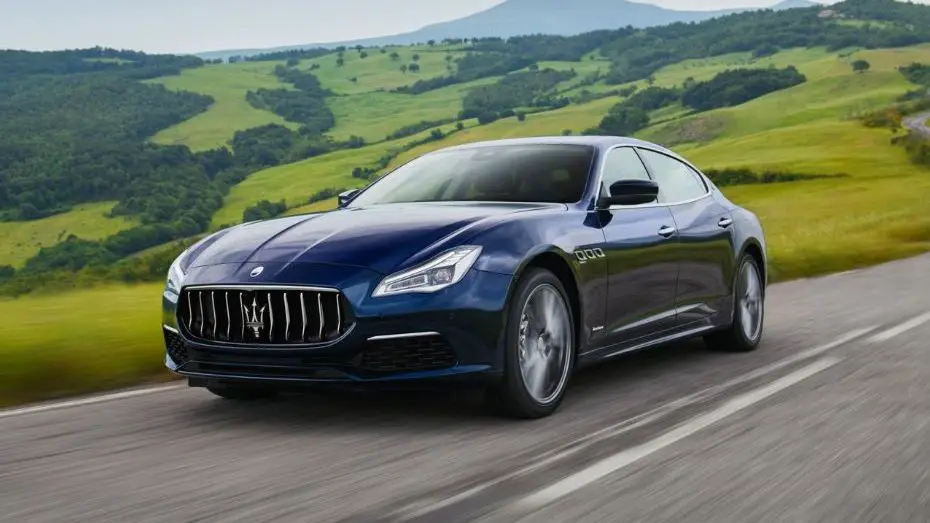Maserati Quattroporte 2023 Brake System User Manual
Introduction
The Maserati Quattroporte 2023’s brake system is made up of a number of essential parts that work together harmoniously to provide the best braking performance possible. Modern engineering and technology are incorporated to guarantee responsive and reliable braking under a variety of driving circumstances. The disc brake setup, which typically consists of sizable ventilated brake discs and powerful brake calipers, is one of the brake system’s key components. Together, these parts create the friction required to effectively slow down and stop the vehicle.
Advanced braking technologies like the electronic brake-force distribution (EBD), brake assist, and anti-lock braking system (ABS) may be included in the Quattroporte to improve braking performance. When braking suddenly or on slick surfaces, ABS helps prevent wheel lock-up, maintaining steering control and stability. EBD makes sure that each wheel receives the proper amount of braking force, enhancing stability and stopping distance. In order to reduce the stopping distance during emergency stops, brake assist adds more braking force.
The Quattroporte might also come with performance brake options like carbon-ceramic brakes. These compact, high-performance brakes are perfect for track use and spirited driving because they have excellent heat dissipation and stopping power. In order to provide confident and secure braking performance, the brake system of the Maserati Quattroporte 2023 combines cutting-edge technology, precise engineering, and high-quality components. The Quattroporte’s brake system is created to inspire confidence and provide a responsive and controlled driving experience, whether you’re navigating city streets or pushing the limits on the open road.
Parking Brake
The vehicle is equipped with an electric automatic parking brake, also called EPB (Electric Parking Brake).
The EPB braking action on model with “Base” braking system (equipped with rear floating caliper) is ensured by a power actuator directly working on the brake pad inside each caliper of the rear brake system.
All other braking system (“Performance Dual Cast” and “Dual Cast”) are equipped with a dedicated caliper which acts on each rear brake disc.
It can be automatically engaged when the engine is turned off and disengaged with engine running, driver seatbelt latched and driver door closed, while pressing the brake pedal and operating the shift lever.
Furthermore, EPB can be automatically engaged above a slope threshold with the transmission in P (Park) to avoid damage to the vehicle. EPB can be disengaged before turning off the vehicle.
When the parking brake is applied, the warning light (United States market) or![]() (Canadian market) lights up on the tachometer display and the related message is displayed on the instrument cluster for 5 seconds (see “Warning and Indication Lights” in section “Dashboard Instruments and Controls”).
(Canadian market) lights up on the tachometer display and the related message is displayed on the instrument cluster for 5 seconds (see “Warning and Indication Lights” in section “Dashboard Instruments and Controls”).
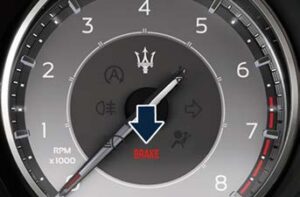
United States Market

Canadian Market
During engagement and disengagement procedures, the warning light
(United States market) or![]() (Canadian market) flashes until the parking brake has reached its maximum activation force and is respectively fully released.
(Canadian market) flashes until the parking brake has reached its maximum activation force and is respectively fully released.
In the above-mentioned conditions, the automatic engagement function can be deactivated/activated by selecting the menu item “Vehicle settings” on the main menu (refer to paragraph “Deactivating Automatic Operation” in this chapter).
Manual Engagement/ Disengagement
The parking brake can also be manually engaged or disengaged when the engine is running or the ignition device is in the RUN position, by pressing the brake pedal and raising the lever located behind the shift lever.
When the parking brake is applied, the warning light (United States market) or ![]() (Canadian market) lights up on the tachometer and the related message will be displayed for 5 seconds on the instrument cluster.
(Canadian market) lights up on the tachometer and the related message will be displayed for 5 seconds on the instrument cluster.
If you attempt to engage/disengage the parking brake without having pressed the brake pedal, a message will be displayed, warning you to proceed.
If the engine was turned off when the automatic engagement device was deactivated (see “Deactivating Automatic Operation” in this chapter)
it is possible to shift the parking brake simply by pulling the lever upward within 3 minutes after turning off.
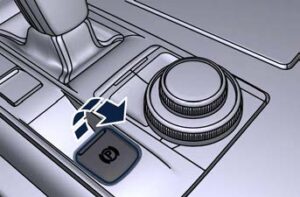
CAUTION!
The main function of the EPB is to allow safe parking of the vehicle, therefore it must only be applied when the vehicle is already stationary. If the EPB is used while the vehicle is moving and decelerating until a speed lower of 3 MPH (5 km/h) and, in particular, until complete stop (typically in a sudden brake), it is necessary to have the
EPB system checked checked by an Authorized Maserati Dealer.
WARNING!
- Always hold the brake pedal pressed during engagement or disengagement of the parking brake.
The EPB command activation while running generates a deceleration of the vehicle with strong deceleration - (Dynamic Braking). It is therefore recommended to use this function only in case of emergency. When the handbrake is activated, the vehicle stability will not be affected when ESC is engaged.
- It is advisable to keep the “Auto Apply” function always active (On) so that the vehicle is properly secured with electric parking brake.
Deactivating Automatic Operation
The automatic engagement function can be deactivated/reactivated by selecting the menu item “Vehicle settings” through the switch on the right-side of the steering wheel (refer to “TFT Display Setting and Menu Overview” in section “Dashboard Instruments and Controls”.) Press and release the multifunction switch toward the arrow to select
“Electric Park Brake”.

Press and release the switch once again toward the arrow to visualize the options connected to this function.
- Auto Apply On (recommended setting);
Auto Apply Off.
WARNING!
It is advisable to keep the “Auto Apply” function always active (On) so that the vehicle is properly secured with electric parking brake.
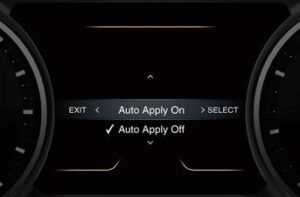
Scroll with the multifunction switch toward the arrow or through the programmable options.
Press and release the multifunction switch toward the arrow to set the selected option. A check mark will remain next to the previously-selected item until a new selection is made.

“Setting Saved” Selection notification appears as a popup for 2 seconds then the display will show again the modified function.

In order to disable the automatic operation follow the same procedures and select the other option.
CAUTION!
- Under certain conditions when the battery voltage is low, the electric automatic parking brake system may temporarily be deactivated for safety reasons. Therefore, typically upon starting the engine, when the battery voltage drops, a message may temporarily be displayed, indicating that automatic operation is temporarily disabled.
In case of repetitive requests to reset the EPB through the messages shown on the TFT display, please contact the Authorized Maserati Dealer.
Failure Indication
In the event of electric parking brake system failure, the warning light on the display will flash for 10 seconds and the related message will show as long as the failure is present.
In addition, the warning light will flash for 10 seconds.
WARNING!
In the event of an EPB failure, take your vehicle to the nearest Authorized Maserati Dealer as soon as possible.
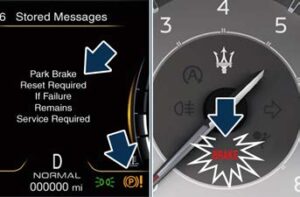
Initialize the EPB System after Re-connecting the vehicle battery
After the detachment and the subsequent connection of the battery, on the instrument cluster display the warning light will be illuminated. To initialize the EPB system, lift, release and lift again the lever located behind the shift lever.
After having initialized the EPB system, the error messages regarding the unavailability of the radar functions shown in the pictures will be displayed on the instrument cluster. In the next key cycle, the messages will no longer be present.
Emergency Disengagement
In case of brake lock with complete electrical system failure, it is necessary to force the electric actuator on the rear calipers (see “Emergency Release of the Parking Brake” chapter in section “In an Emergency”).
EPB Operation with Overheated Brakes
Driving on mountain roads with steep slopes or a sports use of the vehicle could overheat the brake system components. In these conditions, parking brake must not be used since the push of the power actuator might not be sufficient to ensure vehicle braking, especially on a slope.
Drive normally without braking to allow the brakes to cool down a few minutes before stopping. In this way, the automatic or manual activation of the parking brake will ensure vehicle braking.
Parking
Before leaving the vehicle, make sure that the parking brake is fully applied and place the transmission lever in the P (Park) position by pressing the “P” button.
WARNING!
Always check that the vehicle is locked before leaving it.
Never leave children unattended in the vehicle.
Do not park the vehicle on paper, grass, dry leaves or other flammable materials. They could catch fire if they come into contact with hot parts of the exhaust system.
Do not leave the engine running while the vehicle is unattended.
WARNING!
Never use the P (Park) position as a substitute for the parking brake. Always apply the parking brake firmly when parked, including when parked on an incline, to guard against vehicle movement and possible injury or damage.
When parking on hill roads, it is important to turn the front wheels toward the curb on a downhill grade and away from the curb on an uphill grade.
Apply the parking brake before placing the shift lever in P (Park), otherwise the load on the transmission locking mechanism may make it difficult to move the shift lever out of P (Park).
In certain conditions, it is however advisable to disengage the parking brake manually and slightly apply the service brake for starting off. This is advisable when there are obstacles very close to the vehicle in the direction in which you intend to move.
“Drive Away Inhibit” strategy
In order to avoid a dangerous condition resulting from leaving the vehicle “not braked” with running engine and without driver on board, “Drive Away Inhibit” strategy alerts the driver with messages on the instrument cluster display and sounding chimes, then puts the transmission in P (Park).
The table shows the vehicle condition and the action that the system runs to exit the dangerous condition.
| Vehicle Condition | Action of the Driver | The system puts the transmission in P (Park) position. |
|
The driver releases the brake pedal to get out of the vehicle. | |
| Warnings | Warnings | |
|
|
Using the Brakes
CAUTION!
To obtain a good performance by brake pads and discs, avoid sudden braking during the first 190 mi (300 km).
The pad wear limit is indicated by the illumination of the warning light
on vehicles of United States market or of the specific warning light on vehicles of Canadian market and by a message on the instrument cluster.
In this event, please contact an Authorized Maserati Dealer.

United States Market
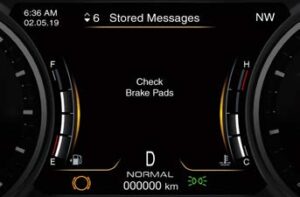
WARNING!
Riding the brakes can lead to brake failure and possibly an accident. Driving with your foot resting or riding on the brake pedal can result in abnormally high brake temperatures, excessive lining wear, and possible brake damage.
In an emergency full braking capacity may be impaired.
Brake Pads and Brake Discs
Wear on the brake pads and brake discs depends to a great extent on the driving style and the conditions of use and therefore cannot be expressed in actual kilometres/miles driven on the road. The brake system is designed for optimal braking effect at all speeds and temperatures.
Certain speeds, braking forces and ambient conditions (e.g. temperature, humidity and long outdoor stopping periods) can therefore cause the brakes to “squeal”. This is normal and will cease after a few breakings.
New Brake Pads and/or Brake Discs
New brake pads are already “bed in”, and therefore only attain optimal friction to the brake disc.
During the first period, the braking system may make a noise, but it will disappear over time.
Brake Overheating
Driving on mountain roads with steep slopes or a sports use of the vehicle could overheat the brake system components. In these conditions, parking brake must not be used since the push of the power actuator might not be sufficient to ensure vehicle braking, especially on a slope.
Drive normally without braking to allow the brakes to cool down a few minutes before stopping. In this way, the automatic or manual activation of the parking brake will ensure vehicle braking.
Brake overheating could also cause “squeals” and “vibrations”.
Use of the Engine
Breaking-In
Today’s most modern production methods are designed to provide extremely precise construction and assembly of components. However, moving parts do undergo a settling process, basically in the first hours of vehicle operation.
Do not drive keeping at a constant high speed rate for a prolonged time.
While cruising, brief full-throttle acceleration within the limits of local traffic laws contributes to a good break-in. Wide-open throttle acceleration in low gear can be detrimental and should be avoided.
The engine oil installed in the engine at the factory is a high-quality energy conserving type lubricant. Oil changes should be consistent with anticipated climate conditions under which vehicle operations will occur. For the recommended viscosity and quality grades, see “Refilling Table” in section “Maintenance and Care”.
A new engine may consume some oil during its first few thousand miles of operation. This should be considered as a normal part of the break-in and not interpreted as an indication of malfunction.
Specific Requirements
Avoid exceeding 5000 rpm for the first 620 mi trip (1000 km).
After starting the vehicle, do not exceed 4000 rpm until the engine has warmed up sufficiently (coolant temperature:
149-158 °F /65 70 °C).
While Driving
Never travel with the tachometer indicator approaching the peak rpm, not even downhill. When the tachometer indicator is approaching the peak rpm (red colored zone), take precautions to avoid exceeding that limit.
Ensure proper operation of different devices checking their respective control telltales.
CAUTION!
Under normal conditions, all red warning lights on the instrument cluster display should be off. When they come on, they indicate a malfunction. Refer to
“Warning and Indicator Lights” in section “Dashboard Instruments and Controls”.
WARNING!
Continuing to drive when a red warning light is on could cause serious damage to the vehicle and affect its performance.
On-Board Diagnostics (OBD)
Your vehicle is equipped with a sophisticated on-board diagnostic system. This system monitors the performance of the emissions, engine, and automatic transmission control systems. When these systems are operating properly, your vehicle will provide excellent performance and fuel economy, as well as engine emissions well within current local regulations of various countries.
If any of these systems require service, the system will turn on the Malfunction Indicator Light (MIL). It will also store diagnostic codes and other information, which your Authorized Maserati Dealer will use to service your vehicle. Although the vehicle will still be driveable and not need towing, contact an Authorized Maserati Dealer for service as soon as possible.

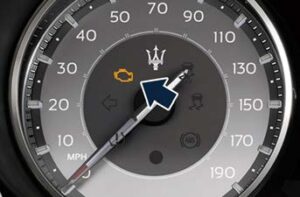
CAUTION!
- Prolonged driving with the
 Malfunction Indicator Light (MIL) on could cause further damage to the emissions control system. It could also affect fuel economy and drivability. The vehicle must be serviced before any emissions tests can be performed.
Malfunction Indicator Light (MIL) on could cause further damage to the emissions control system. It could also affect fuel economy and drivability. The vehicle must be serviced before any emissions tests can be performed. - If the
 Malfunction Indicator Light (MIL) is flashing while the engine is running, severe catalytic converter damage and power loss could occur. Immediate service is required at an Authorized Maserati Dealer.
Malfunction Indicator Light (MIL) is flashing while the engine is running, severe catalytic converter damage and power loss could occur. Immediate service is required at an Authorized Maserati Dealer. - After the problem has been solved, the Authorized Maserati Dealer personnel will perform specific tests for a complete check of the system and, if necessary, road tests.
Spare Parts
Use of genuine Maserati parts for normal or scheduled maintenance and repairs is highly recommended to ensure excellent performance.
Damage or failures caused by non-genuine spare parts used for maintenance and repairs will not be covered by the manufacturer’s warranty.
FAQs
- What type of brake system does the Maserati Quattroporte 2023 have?
An effective disc brake system is typically included in Maserati Quattroporte 2023 models. - Are the brakes on the Maserati Quattroporte 2023 equipped with anti-lock braking system (ABS)?
Yes, an anti-lock braking system (ABS) is included with the Maserati Quattroporte 2023 to help prevent wheel lock-up during hard braking. - Does the Maserati Quattroporte 2023 have electronic brake-force distribution (EBD)?
Electronic brake-force distribution (EBD), which optimizes the distribution of braking force to each wheel for improved stability and stopping performance, is usually incorporated into Maserati Quattroporte 2023 models. - What is the purpose of the brake assist feature in the Maserati Quattroporte 2023?
The Maserati Quattroporte 2023’s brake assist system adds more braking power during emergency stops to help shorten stopping distances. - Does the Maserati Quattroporte 2023 have a regenerative braking system?
Regenerative braking is not typically a feature of the Maserati Quattroporte 2023. For deceleration, it mainly uses conventional friction brakes. - What are the advantages of carbon-ceramic brakes, and are they available on the Maserati Quattroporte 2023?
The answer is that carbon-ceramic brakes have better performance, are lighter, and have better heat dissipation. On some 2023 Maserati Quattroporte models, they might be an optional upgrade. - Can the brake pads on the Maserati Quattroporte 2023 be easily replaced?
The replacement of the brake pads on a Maserati Quattroporte 2023 is typically done by trained mechanics, and it might be necessary to use specialized tools and equipment. - How often should the brake fluid be replaced in the Maserati Quattroporte 2023?
The Maserati Quattroporte 2023’s brake fluid should be changed in accordance with the manufacturer’s suggested maintenance schedule, typically every two years or as indicated by the maintenance system of the car. - Does the Maserati Quattroporte 2023 have a brake wear indicator?
Yes, the brake wear indicator on the Maserati Quattroporte 2023 usually serves to notify the driver when the brake pads are getting close to the end of their useful life. - Can I install aftermarket brake pads on the Maserati Quattroporte 2023?
To ensure the best performance and safety, it is advised to use genuine Maserati brake pads or those made specifically for the Quattroporte. - Does the Maserati Quattroporte 2023 have a parking brake?
The parking brake on a Maserati Quattroporte 2023 is usually activated by a lever or an electronic switch, so the answer is usually yes. - Are the brake rotors on the Maserati Quattroporte 2023 ventilated?
Yes, the Maserati Quattroporte 2023’s brake rotors are usually ventilated to help with heat dissipation and maintain reliable braking performance. - Can the Maserati Quattroporte 2023 automatically apply the brakes in emergency situations?
In response, the Maserati Quattroporte 2023 might come equipped with cutting-edge safety features like automatic emergency braking, which can deploy the brakes on its own in certain dire circumstances. - Does the Maserati Quattroporte 2023 have a brake pedal feel adjustment feature?
The brake pedal feel adjustment feature is typically absent from the Maserati Quattroporte 2023. The brake pedal, on the other hand, is made to feel firm and responsive.
Useful Links
View Full User Guide: Maserati Quattroporte 2023 User Manual | Auto User Guide
Download Manuals: On-Board Owner Documentation | Maserati

